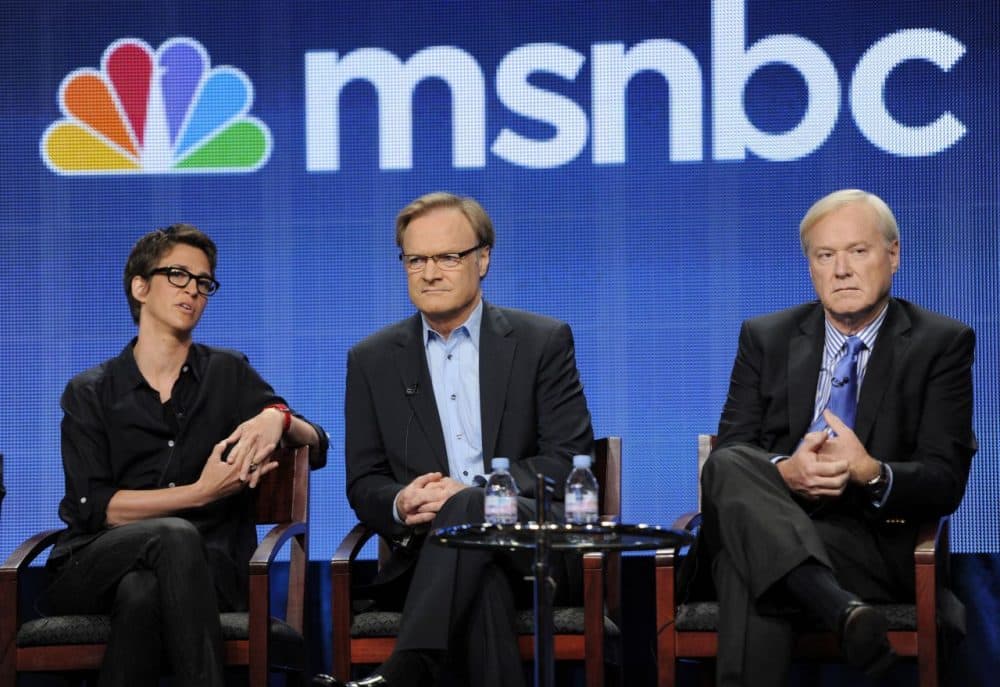Advertisement
'The Outrage Industry' Examines Polarizing Political Commentary

In the age of talk radio and cable news on TV, personal digs, aimed more at insulting than informing, are all too often the norm. Conservative radio talk show host Rush Limbaugh draws audiences with his colorful talk, while liberal TV host Rachel Maddow is also known for her candor.
Jeff Berry, professor of political science at Tufts University, calls all of this "the outrage industry" and explains the rise of this media genre in a new book, "The Outrage Industry: Political Opinion Media and the New Incivility," which he co-authored with Sarah Sobieraj. Berry joined WBUR's Morning Edition.
Jeff Berry: This is a business that tries to polarize us—that’s their function in the business world. They make money by offering political commentary that gets us riled up about the political system.

Bob Oakes: Before I dip deeply into business, let me ask about consumers. What draws people on the radio and on the TV to such programs? What’s your research find about that?
Yes, the audience—it’s a niche audience. A lot of people hate this stuff, but let me give you an estimate based on Nielson ratings, Arbitron ratings and some ratings from the Internet: we find that the average daily audience is 47 million people for this programing. That’s MSNBC, Fox, talk radio--which is the biggest part of the industry--and the top political blogs. So that’s a very, very large audience that wants to hear, read or listen to this stuff.
And why?
It’s interesting. First of all they do feel they’re being informed so that’s a good thing—they’re engaged. But the business model is that it engages people in a way that makes them angry, so that the hosts of these programs on talk radio and on TV, they are very good at getting you riled up and really angry at the other side—the idiots on the other side, whether it be conservatives or liberals.
It pushes buttons. When I was reading the book, I couldn’t help but think that in a way it’s a little bit like fighting in pro hockey. We expect it. It’s part of the game, and for some fans if they don’t experience it at any given game they feel a little bit of a letdown. And for viewers and listeners of the outrage industry I imagine it’s a little bit of the same thing.
Yeah that’s a great analogy. It’s a genre, and you expect this and you’ve come to trust the hosts. So a lot of the business is built around hosts like Rush Limbaugh, Bill O’Reilly, Rachel Maddow—these are people that you trust, and you want to hear what they have to say about the events of the day, and you’re waiting for them to throw the punch. You’re waiting for them to just excoriate the other side and take them to a level that is going to make you just furious. And yet at the same time it comforts you by knowing that these people are on your side and you are right thinking because they reassure you. They validate your feelings as a political observer.
All right now the business side: Is it a successful business? And what fostered its growth?
What fostered its growth was technological change. It used to be that when you watched the network news it would have to be very broad and reach an audience that had many different components. Once cable TV came along, you could make money through finding a niche audience. So as much as we focus on Fox, for example, the largest Fox program, which is “The O’Reilly Factor,” draws only 3 million people a night.
But it can make money because it doesn’t have the requirements of a big news network. And so they find advertisers that want to reach their demographic, which is older, white males, and they have very low productions costs. It doesn’t cost a lot of money to put a program on cable where people are just sitting around talking.
Now we’ve been talking mostly about Fox, but this is not an industry, the outrage industry, practiced only by the right, the political conservatives.
No, it’s not. We find it is the same business model. MSNBC is the network where Martin Bashir said that someone should defecate in Sarah Palin’s mouth. It is the network where Lawrence O’Donnell made fun of the Mormon Church, so they are trying to do the same thing that Fox does, and that is to provoke. There is a difference between left and right, though, in audience size. The audience on the conservative side is much larger.
Where is social media in this? Do you think since anyone can have a comment about anything and say it in any way, does that sort of add to the overall outrage out there?
Yeah the social media act as megaphone for the outrage industry because the people on social media are not themselves. What they’ll do is they’ll take something from a program, and they’ll tweet it or they’ll put it on their Facebook page. But I don’t think social media is the source of this, but rather a reflection of it.
In a piece that you wrote for Politico you said that outrage has been a fundamental part of the American media landscape and then you pose a question: should we worry? What’s your answer?
Yes, I think we should worry because I think that one problem is that people who watch conflate commentary with news and feel that they’re hearing the news. They’re not. They’re hearing people talk about the news and offering opinions, and that’s not the news, and it’s highly inaccurate and highly hyperbolic.
The other danger is that the outrage industry is adding to the dysfunction of our Congress by making it difficult to compromise. So people who are compromisers are denounced on talk radio. The outrage industry feeds on that, and because of the primary system in this country, members of Congress are afraid of people running at them from the far right or the far left. And it pulls them in that direction and makes it that much more difficult to find middle ground.
Considering a lot of this all about speech, do you see signs that the government may try to regulate this industry or can it, given the first amendment?
No, it cannot. The outrage industry was created by the market. If it’s to fall, it will do so because of market forces. So as long as there are audiences there will be advertisers that want to reach those audiences and right now there are audiences, and I don’t see that audience declining significantly.
This article was originally published on February 03, 2014.
This segment aired on February 3, 2014.
